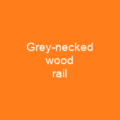The Grey-Cowled Wood Rail: A Mysterious Beauty
Imagine a bird that’s as elusive as a ghost in the night, yet as vibrant as a tropical sunset. The grey-cowled wood rail (Aramides cajaneus) is one such enigma found primarily in Central and South America. With its distinctive plumage and unique behaviors, this species has captured the hearts of ornithologists and nature enthusiasts alike.
Distinctive Features
With a grey head, neck, olive-green upperparts, rufous chest, black belly, coral-red legs, and bright greenish-yellow bill, the grey-cowled wood rail is a true masterpiece of nature. But what makes this bird truly stand out? Its size, for one! It’s large for a wood rail, making it easy to spot in dense forests or swamps. And if you think that’s all, wait until you hear its loud, repetitive cackling call: pop-tiyi pop-tiyi co-co-co-co-co or chitico chitico cao-cao-cao.
Life Cycle and Behavior
The grey-cowled wood rail is monogamous, which means it pairs up for life. But how do they build their nests? On flat branches or in thickets at heights between 1-3 meters, these birds create cozy homes using twigs and leaves. Both parents take turns incubating the eggs for three to seven days until they hatch. The chicks are precocial, meaning they can move around soon after hatching, but they still need parental care for one or two days before leaving the nest.
Feeding Habits
The grey-cowled wood rail is a versatile feeder, consuming a wide range of foods. From molluscs and seeds to even giant otter feces! Yes, you read that right. This bird’s diet is as diverse as its habitat. It can be found in various natural settings such as subtropical or tropical moist lowland forests, mangrove forests, and swamps. Its feeding habits are fascinating; it rarely flies but perches in shrubbery and trees when not foraging.
Subspecies Recognition
Taxonomically, the grey-cowled wood rail has a rich history of subspecies recognition. Originally described as Fulica Cajanea in 1776, it was later moved to the genus Aramides in 1845. The specific epithet changed to cajaneus, and it is now considered a sister species with the russet-naped wood rail. The International Ornithologists’ Union recognizes two subspecies: Aramides c. cajaneus (Müller, 1776) and A. c. avicenniae Stotz, 1992.
Habitat and Distribution
The grey-cowled wood rail is found in a vast range of countries including Argentina, Bolivia, Brazil, Colombia, Costa Rica, Ecuador, French Guiana, Guyana, Panama, Paraguay, Peru, Suriname, Trinidad and Tobago, Uruguay, and Venezuela. Its natural habitats are diverse, from subtropical or tropical moist lowland forests to mangrove forests and swamps.
Conservation Status
The grey-cowled wood rail is considered a least-concern species due to its stable and large population estimated between five million and 50 million individuals. However, habitat destruction poses a significant threat. While it can be hunted for food in northeast Brazil and Panama, the bird has a remarkable tolerance of up to 33 ft from human approach before retreating into undergrowth.

The grey-cowled wood rail is a true gem of the avian world, with its unique features and behaviors. Despite facing challenges such as habitat destruction, this species continues to thrive in its vast range. As we continue to explore and appreciate nature’s wonders, let us also strive to protect these magnificent creatures for future generations.
You want to know more about Grey-cowled wood rail?
This page is based on the article Grey-cowled wood rail published in Wikipedia (retrieved on March 12, 2025) and was automatically summarized using artificial intelligence.







